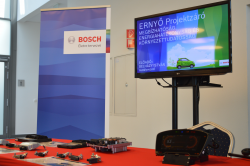 “Safety comes first. If we can save only one life on the roads, we have worked well. But there is obviously much more to talk about here” project manager Balázs Marczis says. In the 1920s, cars were still primarily mechanical machines. It took many decades for them to become machines that could be hardly controlled without electronics. It took 70 years until the change took place in the 1990s. Only 25 years have passed since then, but the world – including the automotive industry – has changed much more.
“Safety comes first. If we can save only one life on the roads, we have worked well. But there is obviously much more to talk about here” project manager Balázs Marczis says. In the 1920s, cars were still primarily mechanical machines. It took many decades for them to become machines that could be hardly controlled without electronics. It took 70 years until the change took place in the 1990s. Only 25 years have passed since then, but the world – including the automotive industry – has changed much more.
ABS, ESP, ESC, TSP, BLIS, CBC, EBD, HDC, SBC, ACC, ASR... We know these acronyms, though their meaning may be less clear to us. It is, however, clear to everyone that they were all invented for us, drivers and passengers. Bearing in mind the importance of safety systems, Bosch has spent almost HUF 7 billion (EUR 22.2 million) on research and development in the field of transportation technologies.
The camera system developed by Bosch not only increases comfort, but also driving safety. Probably all drivers have experienced distraction when their attention was drawn away from the road for a few seconds. In such cases the driver may not perceive the stop sign or the indications of speed limits. The Bosch system recognizes and interprets road signs and, if the driver fails to respect them, sends a warning. In addition, the system always functions according to the real-life situation and not on the basis of previously uploaded and perhaps already outdated GPS data.
The radar sensors can see through fog, rain and heavy snowfall. If all cars were equipped with a radar emergency braking system, never again would we see TV news about pile-ups of 50-60 cars on the motorway, as the sensor would detect any obstacle ahead on the road and would immediately activate the braking system. It would do the same when seeing a pedestrian in front of the car. The average driver reaction time is 0.5 second. During this period of time, a car going at 30 mph will travel 23 feet. Even 7 inches can mean life or death, let alone 23 feet. The radar system’s electronic brain, however, takes action without delay.
Bosch engineers think that the protection of human lives comes first, the mitigation of damage is only a bonus. Parking assistance radars, cameras and ultrasonic sensors help drivers to park in smaller places without damaging the paintwork or, more importantly, the bodywork.
It would be fair to ask: what is new in these technologies, as we have already seen most of the above-mentioned features on the roads as convenience or safety add-ons. Well, a separate unit may increase driving safety, but in addition to developing sensors further and bringing down their prices, the real forward-looking solution is to integrate them into a single system. Bosch’s innovations are forward-looking; a step on the road to a world where built-in car safety systems no longer function as separate units but let vehicles to communicate with each other. If, say, on a frosty winter morning, a car’s electronic system detects ice on the road, it warns nearby cars of the danger, so that they can slow down in time and avoid any accident.
Of course, by the time such technology becomes globally available, cars will probably no longer run on gasoline but will be driven by some alternative technology. To this end, Bosch develops systems that exploit the potential – and voltage – of batteries much more efficiently. Today, if we start the car engine, the generator starts to charge the battery no matter if it is charged or not. The Bosch system takes into account the status and charge level of the battery, and adjusts the charging process accordingly. When battery life is nearing its end, the system can warn the driver to visit a service point. This way, the car will never again ruin your ski holiday by refusing to start at the end of a tiring day. German ADAC statistics show that battery failure is the most common cause of breakdowns. However, cars equipped with the Bosch battery sensor generate 10 percent fewer mistakes.
Budapest University of Technology and Economics and the University of Miskolc also contributed to the success of the project. In the course of the cooperation, the universities were assigned dedicated tasks which can provide long-term help to Bosch. Researchers at the University of Miskolc studied soldering materials and examined the properties of different components. As Bosch has no suitable laboratory for this, project leaders think that universities are excellent partners in performing similar basic research projects. The Budapest University of Technology and Economics dealt with similar long-term problems, which have relevance to other projects as well. Wireless communication and bluetooth technology carry a significant security risk, as data transfer may be vulnerable to interception. The University research team tried to detect and prevent such vulnerabilities.
Although the project has been successfully completed, Bosch does not stop but will continue to work in collaboration with its partners to replace the label “Made in Hungary” in increasingly more cases to “Invented in Hungary”.
Funded project: ERNYO_13-1-2013-0007
Technologies to be developed at Robert Bosch Kft. serving passenger safety, driving assistance, reliability, energy efficiency and environment consciousness
Amount of funding: HUF 2 billion






